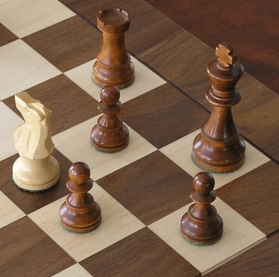
Double Attack - The Ultimate Tactical Concept
This week we’ll take a look at the extremely important concept of Double Attack, in which one piece attacks two enemy pieces at the same time (that’s the definition championed by Martin Weteschnik in his magnificent book, CHESS TACTICS FROM SCRATCH, 2nd Edition), or in which one move creates two different threats at the same time (the Discovered Attack, which was looked at last week, is also a form of double attack). The idea of a Double Attack being defined as two different threats is championed by Yuri Averbach in his classic tome, CHESS TACTICS FOR ADVANCED PLAYERS. At times a Double Attack is an obvious way to win (or regain) material, but at other times it’s a very important cog in a far greater combinative concept.
Since a Double Attack is an “umbrella” that covers most other tactical themes, the common fork should also be considered a Double Attack:
This was pretty but simple. However, our next example shows the “fork as double attack” (and also a Rook move that creates a double attack) in a far more complex setting:
As you can see, if you don’t master the basic “bone structure” of the tactical themes, using them in truly difficult settings won’t be possible (don’t despair – this kind of stuff can be hard even for pros!).
When thinking of a Double Attack, one might suppose that a double “threat” means attacking two pieces at the same time (as Weteschnik would have it). However, when Averbakh says “two threats”, he really means two threats, even if nothing is attacked! Here’s a great example of this from his book.
It looks like the game should end in a draw since black’s King can easily stop the f-pawn and, after …Kg6 followed by …Nb1-c3-d5, even win it. However, White actually manages to win the game by creating two very different threats in vastly different areas of the board!
Weteschnik demonstrated a Double Attack by showing a famous game by the great Bent Larsen:
Personally I don’t care how one wishes to define a Double Attack (all these definitions are similar to each other, with different shades of grey tossed in). All that matters is that you’re aware of it, and that you know that some form of Double Attack is the backbone of most tactical themes.
The following puzzles should push the concept home (as usual, after trying to solve a puzzle, please check out the variations and prose hidden in each one by clicking SOLUTION and then MOVE LIST):

